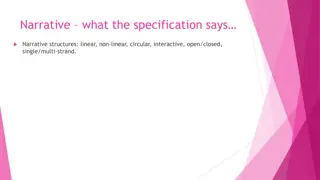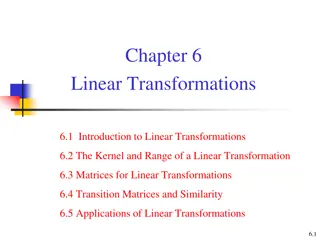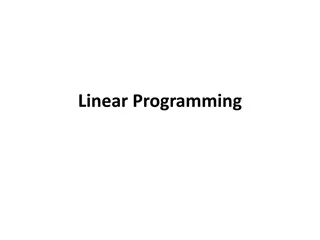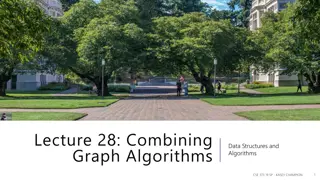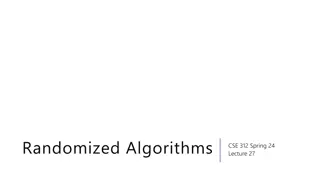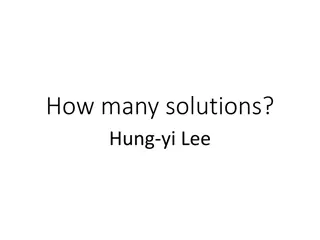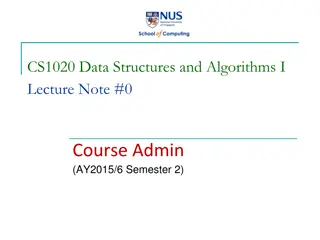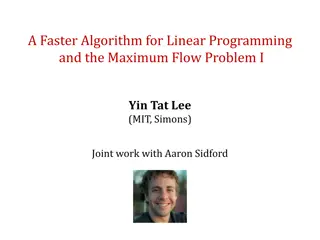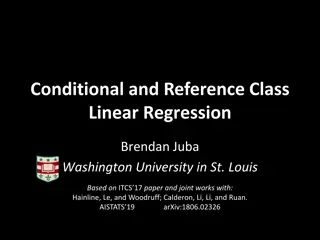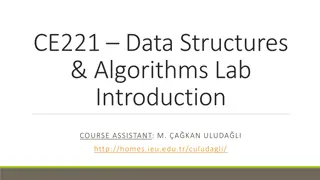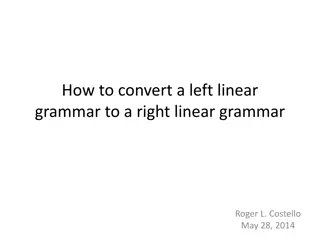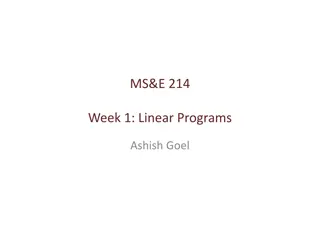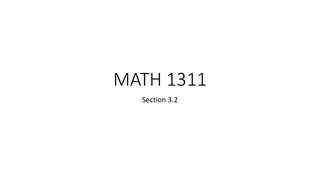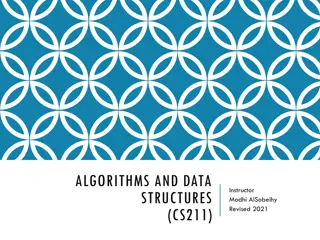Linear Data Structures in Algorithms
Explore the fundamentals of linear data structures through insights on arrays, array indexes, dimensions, array layouts, and static vs. dynamic arrays. Learn how these concepts play a crucial role in computational complexity and revisit algorithms in the context of Dr. Kenneth Cosh's teachings.
Download Presentation

Please find below an Image/Link to download the presentation.
The content on the website is provided AS IS for your information and personal use only. It may not be sold, licensed, or shared on other websites without obtaining consent from the author.If you encounter any issues during the download, it is possible that the publisher has removed the file from their server.
You are allowed to download the files provided on this website for personal or commercial use, subject to the condition that they are used lawfully. All files are the property of their respective owners.
The content on the website is provided AS IS for your information and personal use only. It may not be sold, licensed, or shared on other websites without obtaining consent from the author.
E N D
Presentation Transcript
269202 ALGORITHMS FOR ISNE DR. KENNETH COSH WEEK 2
LAST WEEK Computational Complexity revisited
THIS WEEK Linear Data Structures Revisited Arrays Linked Lists Vectors Sparse Tables
ARRAYS Simplest Data Structure Collection of elements, each identified by an index, or key. E.g. An array of 10 integers could be stored in memory locations 1000, 1004, 1008 1036 In this case the element with index i can be found in memory location 1000 + 4 * i A simple math look up to locate data.
ARRAY INDEXES Each element in an array has an index E.g. MyArray[4], where 4 is in the index. There are 3 ways of indexing elements; Zero Based Indexing The first element in the array has subscript 0. One Based Indexing The first element in the array has subscript 1. N-Based Indexing The base index can be freely chosen could be positive or negative, or any other scalar data type such as enumeration or character. Country[th] = Thailand Country[uk] = United Kingdom
DIMENSIONS Arrays can have multiple dimensions. Single Dimension Array Has 1 index subscript, e.g. myarray[4]; Multidimensional Array Has more than 1 subscript. A 2 dimensional array could be referred to as; myarray[2][3];
ARRAY LAYOUTS Normally arrays are stored in a contiguous area of memory In other words, next to each other. When using a 2 dimensional array, there is a choice between Row-Major Order and Column-Major Order Row Major Order 1,2,3,4,5,6,7,8,9 Column Major Order 1,4,7,2,5,8,3,6,9 Row-Major Order is used in C/C++, Pascal, Python, SAS Column-Major Order is used in Fortran, Open-GL, Matlab
STATIC VS DYNAMIC ARRAYS The memory for a static array is allocated at COMPILATION TIME, so their size is fixed it can t be changed later. int a[10]; The memory for a dynamic array is allocated at RUN TIME, so the size can be altered. int* a = new int[10]; Remember to use the delete command to free up the memory afterwards delete [] a;
DYNAMIC MULTIDIMENSIONAL ARRAYS With a multidimensional static array, the size of each dimension is set at compilation time; int a[4][3]; However, a multidimensional dynamic array is an array of arrays; int** a = new int*[3]; for(int i=0; i<3; i++) { a[i] = new int[4]; } Don t forget to delete the memory afterwards! for(int i = 0; i < 3; i++) { delete[] a[i]; } delete[] a;
JAGGED ARRAYS Each of the arrays can be of a different size! int** a = new int*[3]; a[0] = new int[5]; a[1] = new int[2]; a[2] = new int[4];
PERFORMANCE Getting or setting a value in a particular node (or index) Constant Time Iterating over elements in order Linear Time Inserting or deleting an element from the middle of the array Linear Time Inserting an element at the end of an array Amortised Constant Time
ARRAY BENEFITS Good Locality of Reference Temporal locality & Spatial locality Data Caching Compact Low memory use Random Access
ARRAY LIMITATION The data in an array is separated in computer memory by the same distance, which makes inserting an element inside the array requires shifting other data in the array. This can be overcome by using a linked data structure.
A SIMPLE LINKED LIST P Data Data Data Data Data 0
SINGLY LINKED LISTS The example on the previous page was an example of a singly linked list. A pointer (P) to the first element in the list Each element stores some data, and a pointer to the next element in the list The final element points towards NULL (0), to indicate it is the final element. The data stored in a linked list can be anything from a simple integer to a user defined class.
NODE CODE class Node { public: Node() { next = 0; } Node(int i, Node *in=0) { info = i; next = in; } int info; Node *next; }; This basic node has an integer (info), and a pointer to the next node in the linked list. There are 2 constructors, One for creating an empty list, which points towards NULL One for creating a new node in a list, with info i, again pointing towards NULL
CREATING A LINKED LIST OF NODE Node *p = new Node(1); Creates a pointer p pointing to a new dynamic object of Node type p->next = new Node(2); Creates the second node in the list. p->next->next = new Node(3); Creates the third node in the list.
INSERTION For a basic Linked list, we have two choices for insertion; head_insert() tail_insert() Otherwise known as; push_front() push_back()
HEAD_INSERT p Step 2 Step 1 p tmp Data Data Data Data Data 0 0 p tmp Step 3 p Step 4 Data Data Data Data Data Data 0 0
TAIL_INSERT To insert a node at the end (tail) of a list, we first need a pointer to the last node in the list. It is often a good idea to maintain 2 pointers, one to the head of a linked list, and one to the tail of a linked list. Using the tail pointer, the steps are similar to head_insert.
TAIL_INSERT Step 1 head Step 2 tail head tail tmp Data Data Data Data Data 0 0 Step 3 head tail tail Step 4 head Data Data Data Data Data Data 0 0
INSERTING IN THE MIDDLE OF A LINKED LIST Consider How would you insert a node somewhere in the middle of a linked list? How does this compare to an array?
DELETION Another key operation on a linked list is deletion Deletion from the head Deletion from the tail Deletion from the middle Because linked list nodes are dynamically created we need to be careful to use the delete command to tidy up memory
DELETE FROM HEAD What happens if we try to delete the node that head is pointing to? delete head; head tail head tail Data Data Data ? 0 0
DELETE FROM HEAD So we need to move the head to point to the 2nd node first! head = head->next; tail head head tail Data Data Data Data 0 0 Now what s the problem?
DELETE FROM HEAD So, we need a temporary pointer so we can still delete the first node! Node * tmp = head; delete tmp; tail tail head head tmp head tmp tail Data Data Data Data Data 0 0 0
DELETE FROM THE TAIL What happens if we try to delete the tail node? delete tail; head head tail tail ? Data Data Data 0
DELETE FROM TAIL So first we need to locate the penultimate node! Node *tmp = head; While(tmp->next->next != 0) { tmp=tmp->next; } And then move the tail to point to the tmp node, before deleting the final node. Note:- This is easier to manage if we have a doubly linked list.
DELETE FROM MIDDLE Consider How would you delete a node from the middle of a linked list? How does this compare to an Array?
MORE ON DELETE What happens if we try to delete from an empty list? CRASH? if(isEmpty()) { return 0; } else { } Is it NULL? Or is it a literal 0? What do we need to consider if we are deleting the last node from a list? Where should head and tail be pointing afterwards?
DELETE EFFICIENCY Lets consider the best case:- deleteHead() this will take O(1) How about worst case:- deleteTail() requires iterating through the whole list = O(n) So, what about average case:- Each delete will take between 1 and n, so n/2 on average = O(n)
SEARCH An isInList() function makes use of the following:- tmp = tmp->next; Iterating through each element in the list, until the node is found, or the end of the list is reached. Best Case:- node is at head = O(1) Worst Case:- node at tail, or not in list = O(n) Average Case:- just like delete = O(n)
SINGLY LINKED LISTS A key problem with singly linked lists is seen in deleteTail(); There is no way to access the predecessor node, so deleteTail() needs to iterate through all nodes (n-1) to find it. Therefore an alternative is to create a Doubly Linked List
DOUBLY LINKED LIST Tail Head Data Data Data 0 0
DOUBLY LINKED LISTS Each node has 2 pointers one to the previous node and one to the next node class Node { int data; Node *prev; Node *next; };
TRAVERSAL Doubly Linked Lists can be traversed in both directions Node tmp = head; tmp = tmp->next; tmp = tmp->prev;
INSERTION Insertion is similar to with a singly linked list, but involves more effort to ensure all links are correct. tmp Tail Head Data Data Data Data 0 0
INSERTION tmp Tail Head Data Data Data Data 0 0 0
INSERTION tmp Tail Head Data Data Data Data 0 0
INSERTION Tail Head Data Data Data Data 0 0
INSERTION Insertion at the end of a list is similar to headInsert() As is inserting in the middle of a list The key is to maintain all pointers at all times Extra care needs to be taken in the following situations (again) An Empty List A list with only 1 node.
DELETION Deletion is also similar to with a singly linked list, but involves more effort to ensure all links are correct. Tail tmp Head Data Data Data 0 0
DELETION Tail tmp Head Data Data Data 0 0 0
DELETION Tail Head Data Data 0 0
DELETION A key benefit of Double Linked Lists is tailDelete() Being able to do:- tail = tail->prev; Makes deleting from the tail more efficient. Deleting in the middle of a linked list requires a pointer to the node that needs to be deleted. Again special care needs to be taken when Deleting from an empty list Deleting from a list with only 1 node.
CIRCULAR LINKED LISTS A circular linked list is one where the first node points back to the last node (rather than NULL), and the last node points back to the first node (rather than NULL). In this list there is no end, or beginning, just a pointer to the list. current Data Data Data
CIRCULAR LINKED LISTS Why? Consider a situation where several processors need access to a resource, and need to be given equal fair access to it. The processors can be given a space in a circular linked list, with a current pointer keeping track of which processor s turn it is. Consider a multiplayer board game (poker?) Each player can be placed in a circular linked list, with a current pointer keeping track of who s turn it is. The considerations for designing a circular linked list are similar to those we have already discussed. Maintaining pointers Empty Lists / Lists with one node.
CIRCULAR LINKED LISTS / RING BUFFERS / ARRAYS Let s consider implementing the same problem using an array Sometimes called a circular array or a ring buffer. First index = 0 4 5 7 6 Last index = 3
CIRCULAR ARRAY Of course, the Circular Array is stored as a normal array, with extra variables to store the index number of the first and last element in the array. 4 5 6 7 As we loop through the array, the first variable is incremented, and as new elements are added to the array, the last variable is incremented.
CIRCULAR ARRAY Consider the complexity of adding processors to a Circular Array (compared to adding to a circular linked list). What are the limitations of circular arrays?




